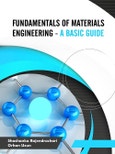Fundamentals of Materials Engineering - A Basic Guide is a helpful textbook for readers learning the basics of materials science. This book covers important topics and fundamental concepts of materials engineering including crystal structure, imperfections, mechanical properties of materials, polymers, powder metallurgy, corrosion and composites.
The authors have explained the concepts in an effective way and by using simple language for the benefit of a broad range of readers. This book is also beneficial to the students in engineering courses at B.Sc, M.Sc, and M.Tech. levels.
Table of Contents
Chapter 1 Introduction to Materials Engineering
1. What is Materials Science and Engineering?
2. What Exactly Material Engineers Do?
3. Classification of Materials
3.1. What are Metals?
3.2. What are Ceramics?
3.3. What are Composites?
4. Learning Objectives
Conclusion
References
Chapter 2 The Structure of Materials
1. Introduction
2. Atomic Bonding
3. Primary Bonding
3.1. Ionic Bonding
3.2. Covalent Bonding
3.3. Metallic Bonding
4. Secondary Bonding
4.1. Hydrogen Bonding
4.2. Van Der Waals Bonding
5. Structure of Metals
6. Lattice, Lattice Points, Motif
7. Unit Cells
8. Crystal Structures of Metals
8.1. Simple Cubic Structure
8.2. Face Centered Cubic (Fcc) Structure
8.3. Body-Centered Cubic (Bcc) Structure
8.4. Hexagonal Close Packing (Hcp) Crystal Structure
8.5. Radius Ratio and Co-Ordination Number
9. Importance of the Radius Ratio Rule
10. Density Computation
10.1. Volume Density (Ρv)
10.2. Planar Atomic Density (Ρp)
11. Crystal Systems
12. Characteristics of the Unit Cell
Conclusion
Questions
Numericals
References
Chapter 3 Imperfections or Defects in Crystals
1. Introduction
2. Types of Defects
3. Point Defects
3.1. Vacancy Defect
3.2. Interstitial Defect
3.2.1. Self-Interstitial Defects
3.2.2. Impurity Interstitial Defects
3.3. Substitutional Defects
4. Line Defects
4.1. Edge Dislocation
4.2. Screw Dislocation
5. Surface Defects
5.1. Grain Boundary Defect
5.2. Twin Boundary Defect
5.3. Staking Fault Defect
6. Volume Defects
7. Strengthening of Materials
7.1. Strain Hardening
7.2. Grain Boundary Strengthening
7.3. Solid Solution Strengthening
7.3.1. Substitutional Solid Solution Strengthening
7.3.2. Interstitial Solid Solution Strengthening
7.4. Precipitation Hardening
7.5. Dispersion Strengthening
Conclusion
Questions
References
Chapter 4 Mechanical Properties of Materials
1. Introduction
2. Tensile Test
3. Engineering Stress-Strain Curves
4. True Stress-Strain Curves
5. Evaluation of Properties
5.1. Proportional Limit or Stress
5.2. Elastic Limit or Stress
5.3. Ultimate Tensile Stress
5.4. Breaking or Fracture Stress
5.5. Yield Stress
5.6. Proof Stress
5.7. Toughness
5.8. Resilience
5.9. Stiffness
5.10. Ductility
5.11. Malleability
6. Types of Engineering Stress-Strain Curves for Different Types of Materials
6.1. Ductile Materials Without Yield Point
6.2. Ductile Materials with a Yield Point
6.3. Brittle Materials
6.4. Polymeric Materials
7. Compression Test
8. Fracture
9. Creep
10. Castability
11. Hardness
11.1. Mohs Hardness Test
11.2. Brinell Hardness Test
11.3. Rockwell Hardness Test
11.4. Vickers Microhardness Test
Conclusion
Questions
References
Chapter 5 Polymers
1. Introduction
2. Properties of a Polymer
3. Classification of Polymers
3.1. Based on the Source
3.1.1. Natural Polymers
3.1.2. Synthetic Polymers
3.2. Based on Structure
3.2.1. Linear Polymers
3.2.2. Branched Polymers
3.2.3. Cross-Linked Polymers
3.2.4. Graft Polymers
3.3. Based on Tacticity
3.3.1. Atactic Polymers
3.3.2. Syndiotactic Polymers
3.3.3. Isotactic Polymers
3.4. Based on Properties
3.4.1. Thermoplastic Polymers
3.4.2. Thermosetting Polymers
3.5. Based on Monomeric Units
3.5.1. Homopolymers
3.5.2. Copolymers
4. Types of Polymerization
4.1. Addition Polymerization
4.2. Condensation Polymerization
5. Differences Between Addition and Condensation Polymerization 91
6. Free Radical Mechanism During Addition Polymerization
7. Ionic Polymerization
7.1. Anionic Polymerization
7.1.1. Initiation
7.1.2. Propagation
7.1.3. Termination
7.2. Cationic Polymerization
8. Synthesis of Some Industrially Important Polymers
9. Polyethylene
9.1. Low-Density Polyethylene
9.2. High-Density Polyethylene
9.3. Properties of Polyethylene
9.4. Applications of Polyethylene
10. Polyvinyl Chloride (Pvc)
10.1. Properties of Polyvinyl Chloride
10.2. Applications of Polyvinyl Chloride
11. Polypropylene
11.1. Properties of Polypropylene
11.2. Applications of Polypropylene
12. Polystyrene
12.1. Properties of Polystyrene
12.2. Applications of Polystyrene
13. Polyamides
13.1. Nylon-6,6
13.1.1. Properties
13.1.2. Applications
13.2. Nylon-6,10
13.2.1. Properties and Applications
13.3. Nylon-6
13.3.1. Properties
13.3.2. Applications
14. Bakelite
14.1. Properties
14.2. Applications
15. Processing of Polymers
15.1. Injection Molding
15.2. Blow Molding
15.3. Compression Molding
15.4. Film Insert Molding
15.5. Gas Assist Molding
15.6. Rotational Molding
15.7. Structural Foam Molding
Conclusion
Questions
References
Chapter 6 Powder Metallurgy
1. Introduction
2. Powder Metallurgy Process
2.1. Manufacturing of Metal Powder
2.1.1. Atomization
2.1.2. Reduction of Metals
2.1.3. Electrolysis Process
2.1.4. Carbonyl Process
2.1.5. Granulation Process
2.1.6. Mechanical Alloying
2.1.7. Production of Fine Metals by Machining
3. Blending of Powders
4. Compacting the Powders in a Mold or Die
5. Sintering
5.1. Sintering in the Powder Metallurgy Process
5.2. Sinter Hardening
5.3. Liquid Phase Sintering
5.3.1. Transient Liquid Phase Sintering
5.3.2. Permanent Liquid Phase Sintering
6. Applications of Powder Metallurgy
6.1. the Automotive Sector
6.2. Aerospace Applications
6.3. Oil and Gas Industry
6.4. Healthcare Sector
6.5. Filters
6.6. Cutting Tools and Dies
6.7. Magnets
6.8. Turbine Disk Super Alloy
6.9. Injection Molded 3C Products
6.10. Sintered Soft Magnetic Materials
7. Advantages and Disadvantages of Powder Metallurgy
7.1. Advantages
7.2. Disadvantages
Conclusion
Questions
References
Chapter 7 Corrosion
1. Introduction
2. Causes of Corrosion
3. What is Corrosion?
4. Outcome of Corrosion
5. Economic Loss
6. Health Effects
7. Technological Effects
8. Cultural Effects
9. Safety Effects
10. Effect of Corrosion on Metals
11. Conditions Necessary for Corrosion
11.1. Corrosion Cell
12. Types of Corrosion
12.1. Dry Corrosion
12.1.1. Oxidation Corrosion
12.1.2. Liquid Metal Corrosion
12.1.3. Corrosion by Other Gases
12.2. Wet Corrosion
13. Differences Between Dry and Wet Corrosion
14. Types of Wet or Electrochemical Corrosion
14.1. Differential Metal Corrosion (Galvanic Corrosion)
14.2. Differential Aeration Corrosion (Concentration Cell Corrosion)
14.3. Waterline Corrosion
14.4. Crevice Corrosion
14.5. Pitting Corrosion
15. Other Types of Corrosion
15.1. Stress Corrosion Cracking
15.2. Intergranular Corrosion
15.3. Microbiological Corrosion
15.4. Soil Corrosion
15.5. Erosion Corrosion
16. Factors Influencing the Rate of Corrosion
Author
- Shashanka Rajendrachari
- Orhan Uzun








